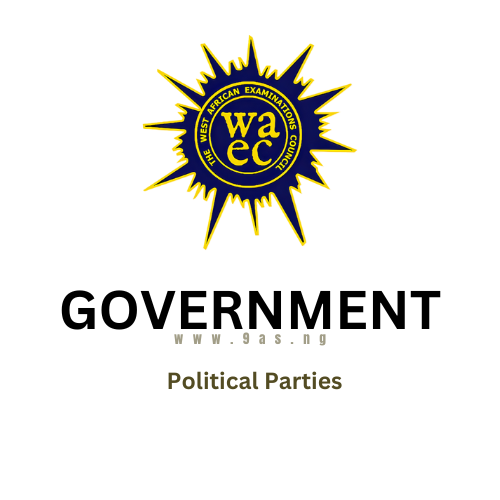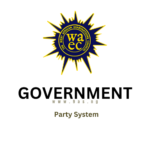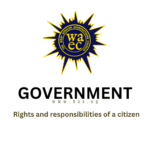THEORY
1. What is party manifesto and why is it necessary?
2. Why is it necessary?
3. Outline the factors which determine the electoral success of a political party.
4. Describe any four functions performed by political parties.
5. Describe any three functions of a political party.
6. State any three problems of political parties.
7. What is a manifesto?
8. Outline five factors that determine the electoral success of a political party.
9. Describe the organizational structure of a political party.
OBJECTIVES
1. Which of the following is not a function of a party secretariat?
A. Electing the leader of the party.
B. Organizing party conferences.
C. Publishing the party’s manifesto.
D. Planning party strategy to win election.
2. The primary objective of all political parties is to
A. promote the general interest of members of the public.
B. eradicate corruption in public life.
C. control the government.
D. campaign for vote.
3.The coming together of two or more political parties to form a government is
A. coalition.
B. merger.
C. unification.
D. co-operation.
3. Which of the following best explains the term mainfesto? The
A. constitution of the political party.
B. authority to form a political party.
C. proposed programme of a political party.
D. symbol of the ruling political part.
4. Political parties are formed for all the following reasons except to
A. form a government.
B. educate the electorate.
C. organize elections.
D. contest elections.
5. A manifesto refers to
A. the register of party members.
B. rejected ballot papers.
C. valid ballot papers.
D. proposed programme of a party.
6. The functions of political parties include the following except
A. being brokers of ideas.
B. influencing policies of the government.
C. educating the electorate by clarifying issues.
D. disseminating information to members.
7. Which of the following is a feature of an elite party?
A. Members are recruited from the working class.
B. The leadership is composed of aristocrats and wealthy merchants.
C. It usually consists of existing associations, clubs and trade unions.
D. Its leadership has certain techniques which attract supporters.
8. The programme of a political party is known as its
A. constitution.
B. document.
C. manifesto.
D. propaganda.
9. Which of the following is not a function of a political party?
A. Educating the government.
B. Interest articulation.
C. Aggregation of opinions.
D. Selection of persons for government.
10. An organization whose ultimate aim is to gain the control of government and implement its
programme is known as
A. pressure group.
B. political party.
C. trade union.
D. professional association.
11. A political party can contest and win a widely accepted election if it has
A. the ability to rig election.
B. intolerant attitude to oppositions.
C. a broad-based membership.
D. the support of very wealthy politicians.
12. Political parties aim at all the following except
A. contesting elections.
B. forming a government.
C. organizing general elections.
D. educating the electorate politically.
13. Which of the following is not a means through which political parties reach the populace?
A. Posters.
B. Newspaper.
C. School.
D. The internet.
14. Which of the following is not the function of political party?
A. Interest aggregation.
B. Interest articulation.
C. Political-integration.
D. Drafting a country’s constitution.
15. The electoral success of political party depends on its ability to
A. rig election successfully.
B. campaign till election day.
C. distribute sufficient funds to voters.
D. present a good and acceptable manifesto.
16. The political party whose membership comprises people of high social status is called
A. religious party.
B. broker party.
C. elite party.
D. mass party.
17. A political party is significant because it
A. stimulates opposition.
C. control the government.
D. ensure fair play in business.
18. The ultimate aim of a political party is to
A. influence government policies.
B. gain control of government.
C. seek to discredit the government.
D. provide for the welfare of its members.
19. An organized group that seeks the control of power in a State is a
A. pressure group.
B. political party.
C. social group.
D. co-operative society.
20. Political parties mobilize the support of the electorate by
A. promoting violence.
B. campaigning.
C. rigging elections.
D. encouraging coup d’états.
21. All the following are sources of revenue of a political party except
A. payment of dues.
B. donations.
C. custom duties.
D. fund raising.
22. Provision of political education through rallies and newspapers is a function of
A. political parties.
B. pressure groups.
C. educated elite.
D. the clergy.
23. Party manifesto is important in the following ways except to
A. evaluate the party.
B. limit choice.
C. attract people.
D. guide the party.
24. Which of the following will produce a weak government?
A. Coalition.
B. Two-party system.
C. General elections.
D. Presidential.
25. Coalition government can be defined as parties coming together
A. to appoint a leader.
B. to form a government.
C. with a common manifesto.
D. to oppose the government.
26. One of the functions of political parties is to
A. make laws.
B. declare a state of emergency.
C. interpret the constitution.
D. aggregate interest.
27. Which of the following facilitates the working of a democratic government?
A. Dormant press.
B. Partial judiciary.
C. Vigilante group.
D. Political parties.
28. A manifesto refers to the
A. national development plan of a country.
B. budget speech of a regime by the President.
C. fundamental human rights provisions in a constitution.
D. programme of a political party.
29. All the following are essential functions of political parties except to
A. aggregate interests of members of the public.
B. serve as link between the government and the people.
C. seek political power lawfully.
D. seek political power for the military.
30. When two or more partiés join to form a government, we have a
A. mixed government.
B. united government.
C. plural government.
D. coalition government.
31. The primary aim of any political party is to
A. pressurize the government.
B. remain in the opposition
C. control the government
D. ensure fair play in business
32. A manifesto can be defined as the
A. opportunity to form a political party.
B. proposed programmes of a political party.
C. policy of a political party in power.
D. power to rule the masses.
33. A group that presents candidates for elections is a
A. political party.
B. pressure group.
C. vigilante group.
D. co-operative society.
34. Which of the following is a type of political party?
A. Anomic party.
B. Mass party.
C. Conglomerate party.
D. Dynamic party.
35. Politics is practically demonstrated during
A. electioneering campaigns.
B. parliamentary debates.
C. formation of political parties.
D. inter-party consultative meetings.
36. Which of the following is not a function of political party?
A. Presenting candidates for elections.
B. Uniting diverse views of different interest group.
C. Forming government after election.
D. Bringing the country’s economic and social conditions under control.
37. Political parties contest elections in order to
A. formulate policies.
B. influence public opinion.
C. control political power.
D. prevent coups d’etat.
38. A coalition government can be described as one which
A. is made up of more than one political party.
B. is formed by the political party that won the election.
C. can enforce the law enacted by the legislature.
D. operates in a presidential system of no government.
39. In the organizational structure of a mass political party, the policy making body is the
A. Secretary General of the party.
B. National Executive Committee.
C. National Chairman.
D. Parliamentary Committee of the party.
40. A political party is mainly interested in
A. contesting elections to gain power.
B. opposing the government in power.
C. educating the public.
D. formulating government policies.
41. One of the important functions of political parties is
A. educating the electorate through rallies and campaigns.
B. organizing international conference.
C. advising on the appointment of judges.
D. hiring personnel for political leader.
42. The manifesto of a political party is a document which outlines
A. a country’s political party development.
B. a party’s programme.
C. the national ideology.
D. the interest of party members.
43. A system in which two or more political parties form the government is called
A. a coalition.
B. an association.
C. a decentralization.
D. a centralization.
44. On which of the following platforms do political parties mainly present their manifestoes to the
electorate?
A. Campaigns and rallies.
B. The state controlled mass media.
C. Public lectures.
D. Inter-party debates.
45. Which of these is not a source of revenue for political parties
A. Dues.
B. Grants.
C. Tolls.
D. Donations.
46. The mass type of party is
A. broad-based.
B.capitalist.
C. feudalist.
D. conservative.
47. Which of the following is a function of the party whip
A. Flogging erring party members.
B. Ensuring that the members tow the party position.
C.Ensuring the safety of the speaker.
D. Assessing the performance of the law makers.
48. The major role of minority parties in parliament is to
A. criticize every government policy.
B.ensure democratic governance.
C.monitor the activities of the president.
D.supervise the passage of bills.
49. The national secretariat of a political party is managed by the
A. presidential candidate.
B. founding members.
C. national chairman and general secretary.
D. national executive and youth organizer.
50. The document which sets out the programme of a political party and guides the electorate to vote for it
is the
A. constitution.
B. electoral register.
C. manifesto.
D. white paper.
51. The action programme of a political party intended to be carried out when political power is won is known as
A. code of conduct.
B. party constitution
C. party survey.
D. manifesto.
52. Which of the following options is not a function of political parties?
A. Policy implementation
B. Political socialization
C. Political education
D. Aggregation of interest
53. A public declaration of policy and aims, especially one issued before an election by a political party or
candidate is commonly called
A. policy paper
B. guide to government
C. manifesto
D. steps to govern



